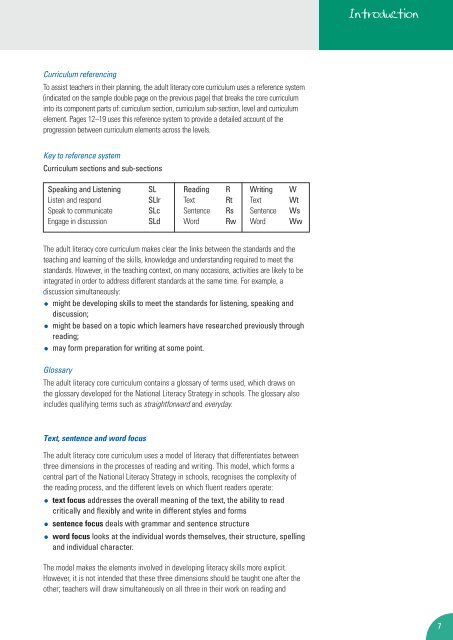Adult Literacy Core Curriculum - Nationally developed Skills for Life ...
Adult Literacy Core Curriculum - Nationally developed Skills for Life ...
Adult Literacy Core Curriculum - Nationally developed Skills for Life ...
You also want an ePaper? Increase the reach of your titles
YUMPU automatically turns print PDFs into web optimized ePapers that Google loves.
<strong>Curriculum</strong> referencing<br />
To assist teachers in their planning, the adult literacy core curriculum uses a reference system<br />
(indicated on the sample double page on the previous page) that breaks the core curriculum<br />
into its component parts of: curriculum section, curriculum sub-section, level and curriculum<br />
element. Pages 12–19 uses this reference system to provide a detailed account of the<br />
progression between curriculum elements across the levels.<br />
Key to reference system<br />
<strong>Curriculum</strong> sections and sub-sections<br />
Speaking and Listening SL<br />
Listen and respond SLlr<br />
Speak to communicate SLc<br />
Engage in discussion SLd<br />
The adult literacy core curriculum makes clear the links between the standards and the<br />
teaching and learning of the skills, knowledge and understanding required to meet the<br />
standards. However, in the teaching context, on many occasions, activities are likely to be<br />
integrated in order to address different standards at the same time. For example, a<br />
discussion simultaneously:<br />
• might be developing skills to meet the standards <strong>for</strong> listening, speaking and<br />
discussion;<br />
• might be based on a topic which learners have researched previously through<br />
reading;<br />
• may <strong>for</strong>m preparation <strong>for</strong> writing at some point.<br />
Glossary<br />
The adult literacy core curriculum contains a glossary of terms used, which draws on<br />
the glossary <strong>developed</strong> <strong>for</strong> the National <strong>Literacy</strong> Strategy in schools. The glossary also<br />
includes qualifying terms such as straight<strong>for</strong>ward and everyday.<br />
Text, sentence and word focus<br />
Reading R<br />
Text Rt<br />
Sentence Rs<br />
Word Rw<br />
Writing W<br />
Text Wt<br />
Sentence Ws<br />
Word Ww<br />
The adult literacy core curriculum uses a model of literacy that differentiates between<br />
three dimensions in the processes of reading and writing. This model, which <strong>for</strong>ms a<br />
central part of the National <strong>Literacy</strong> Strategy in schools, recognises the complexity of<br />
the reading process, and the different levels on which fluent readers operate:<br />
• text focus addresses the overall meaning of the text, the ability to read<br />
critically and flexibly and write in different styles and <strong>for</strong>ms<br />
• sentence focus deals with grammar and sentence structure<br />
• word focus looks at the individual words themselves, their structure, spelling<br />
and individual character.<br />
The model makes the elements involved in developing literacy skills more explicit.<br />
However, it is not intended that these three dimensions should be taught one after the<br />
other; teachers will draw simultaneously on all three in their work on reading and<br />
Introduction<br />
7

















